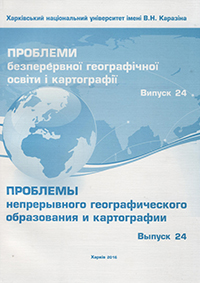Role of cartographic method in the territorial-nosological analysis (on the example of the series of medical-geographical maps of Sumy region)
Abstract
The high level of morbidity in Ukraine and Sumy region has necessitated the creation of a series of medical-geographic maps and atlases, reflecting distribution and dynamics of diseases, their relationship with the natural, socio-economic, environmental conditions. Implementation of nosological-geographical analysis at a present-day scientific level is impossible without the use of cartographic method of research, without creation of health maps and meaningful interpretation of them. Application of cartographical method increases the complexity and accuracy of the territorial nosological-geographical analysis; the role of this method is shown by mapping two different factors of their occurrence in nosological classes: diseases of the usculoskeletal system and neoplasms. Cartographic method allows to show the structure of the musculoskeletal system diseases, among which are the most common arthritis, arthritis, and dorsopathies, spondylopathies. Osteoarthritis most often occurs in residents of Lypova Dolyna (4411.76), Putyvl’ (3783.19), Romny (3521.83) and Hlukhiv (3401.510 cases per 100 thousand residents) districts. As the results of cartographic modeling in Sumy region there is a high incidence of both benign and malignant tumors; the prevalence of the latter in 2014 reached a rate of 416.5 cases per 100 thousand residents. The use of cartographic method has made it possible not only to clearly describe the situation in a given area, but also through a series of medical-geographic maps to identify the chorologic features of diseases incidence and prevalence in the population of these administrative districts.
Downloads
References
2. Kornus, O.H., Shyshchuk, V.D. (2014). Poshy`rennya xvorob sered naselennya Sums`koyi oblasti ta osobly`vosti jogo kartografuvannya
[The prevalence of diseases among the population of Sumy region and especially of its mapping]. The problems of continuous geographical education and cartography, 20, 69-72.
3. Kornus, O.H., Shyshchuk, V.D. (2013) Kartografuvannya zaxvoryuvanosti naselennya oblasnogo regionu (na pry`kladi
Sums`koyi oblasti) [Mapping of morbidity in the regional area (on the example of Sumy region)]. The problems of continuous geographical education and cartography, 18, 94-97.
4. Kornus, O.H., Shyshchuk, V.D., Kornus, A.O. (2014). Medy`ko-geografichny`j analiz zaxvoryuvanosti naselennya Sums`koyi oblasti [Medical and geographical analysis of morbidity in Sumy region]. Journal of socio-economic geography, 17 (2), 112-123.
5. Peresad’ko, V.A. (2009). Naukovo-metody`chni pidxody` do rozrobky` regional`ny`x medy`ko-ekologichny`x kartografichny`x tvoriv rizny`x tery`torial`ny`x rangiv [Scientific and methodological approaches to the development of regional medical and environmental
mapping works of different territorial ranks]. The problems of continuous geographical education and cartography, 10, 165-170.
6. Shevchenko, V.A. (1994). Mediko-geograficheskoe kartografirovanie territorii Ukrainy [Medical and geographical mapping of the territory of Ukraine]. Kiev: Naukоva dumka. 158.
7. Shyshchuk, V.D., Kornus, O.H., Kornus, A.O., Shyshchuk, A.V. (2015). Regional`na sy`stema medy`chnogo obslugovuvannya: suchasny`j stan i osobly`vosti funkcionuvannya (na pry`kladi Sums`koyi oblasti) [The regional health care system: current status and functioning (on the example of Sumy region)]. Journal of Education, Health and Sport, 5 (8),126-136.
8. Shyshchuk, V.D. (2014). Poshy`rennya xvorob kistkovo-m’yazovoyi sy`stemy` sered naselennya Cums`koyi oblasti
[Prevalence of the musculoskeletal system diseases in the population of Sumy region]. The Problems of continuous medical education and science, 2, 26-31.
9. Kornus, A.O., Kornus, O.H., Shyschuk, V.D. (2015). Influence of Environmental Factors on the Population Health: Regional Approach to the Medical-Ecological Analysis (on the Example of Sumy Region of Ukraine). European Journal of Medicine, 8 (2), 84-105.





